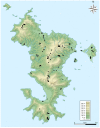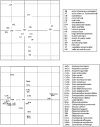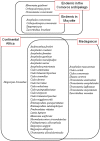Survey of the mosquitoes (Diptera: Culicidae) of Mayotte
- PMID: 25004163
- PMCID: PMC4086827
- DOI: 10.1371/journal.pone.0100696
Survey of the mosquitoes (Diptera: Culicidae) of Mayotte
Abstract
A transversal survey of immature mosquitoes was conducted on Mayotte Island (France) in the Comoros Archipelago, western Indian Ocean, with the aim to inventory the Culicidae and to document inter-species relationships in different habitats. In total 420 habitats were sampled for larvae and/or pupae mosquitoes, resulting in more than 6,000 specimens. Forty species belonging to 15 genera were collected, with eight taxa integrated for the first time to the Mayotte mosquito list. The most frequently recorded species were Stegomyia aegypti, St. albopicta, Anopheles gambiae and Eretmapodites subsimplicipes, the first three species being known vectors of viruses and parasites transmitted to humans. Mean species richness in habitats ranged from 1.00 to 3.29, with notable differences between habitats. For example, water-filled axils of banana leaves, tree-holes and crab-holes had low species richness, while cut bamboo, water pools, abandoned tires and marsh and swamp water had notably higher species richness. Twenty-seven mosquito species belonging to 12 genera were routinely collected (in ≥20% of at least one type of larval habitat) suggesting that multiple species play a role in the biocenosis of these aquatic habitats. Multispecies association was observed in 52% of the habitats. The co-occurrence of up to six species belonging to five genera was recorded in a single habitat. The mosquitoes of Mayotte show notable biogeographical affinities to those of Madagascar, as compared to the African continent. These two potential source areas are nearly equidistant from Mayotte, which in turn indicates biased dispersal from east to west. Our findings suggest that with relatively short-term intensive sampling in different habitats, it is possible to approach exhaustive species inventories based on collection of larvae. Mayotte, with its modest elevation range and land surface, has a notable species richness of mosquitoes with 45 well-documented species belonging to 15 genera.
Conflict of interest statement
Figures





References
-
- Erwin TL (1982) Tropical forests: their richness in Coleoptera and other arthropod species. Coleopt Bull 36: 74–75.
-
- Erwin TL (1983) Beetles and other insects of tropical forest canopies at Manaus, Brazil, sampled by insecticidal fogging. In Sutton SL, Whitmore TC, Chadwick AC, editors. Tropical Rain Forest Ecology and Management. Oxford: Blackwell Scientific Publications. pp. 59–75.
-
- Erwin TL (1983) Tropical forest canopies: The last biotic frontier. Bull Entomol Soc Amer 30: 14–19.
-
- Stork N (1993) How many species are there? Biodiv Conserv 2: 215–232.
Publication types
MeSH terms
LinkOut - more resources
Full Text Sources
Other Literature Sources
Medical

